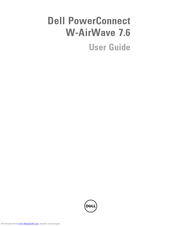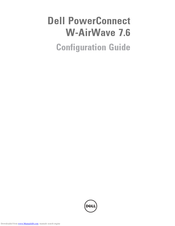Dell PowerConnect W-AirWave 7.6 Manuals
Manuals and User Guides for Dell PowerConnect W-AirWave 7.6. We have 3 Dell PowerConnect W-AirWave 7.6 manuals available for free PDF download: User Manual, Configuration Manual, Server Sizing Manual
Dell PowerConnect W-AirWave 7.6 User Manual (332 pages)
Table of Contents
-
Introduction
13 -
-
-
-
AMP Features32
-
-
-
-
-
-
Deleting a Group105
-
-
-
Group Templates163
-
-
-
-
-
RAPIDS Setup183
-
-
Score Override195
-
-
-
Viewing Triggers203
-
Viewing Alerts211
-
-
-
-
-
-
-
-
Defining Reports270
-
Using Visualrf
277-
Features278
-
Useful Terms278
-
-
-
Overlays280
-
Type Section280
-
Floors Section281
-
Display Menu281
-
Edit Menu282
-
-
-
-
Adding Regions297
-
-
-
-
-
Index
325
Advertisement
Dell PowerConnect W-AirWave 7.6 Configuration Manual (86 pages)
Table of Contents
-
-
-
-
Introduction35
-
AP Overrides40
-
Wlans44
-
Profiles49
-
Security50
-
-
Advertisement
Advertisement


